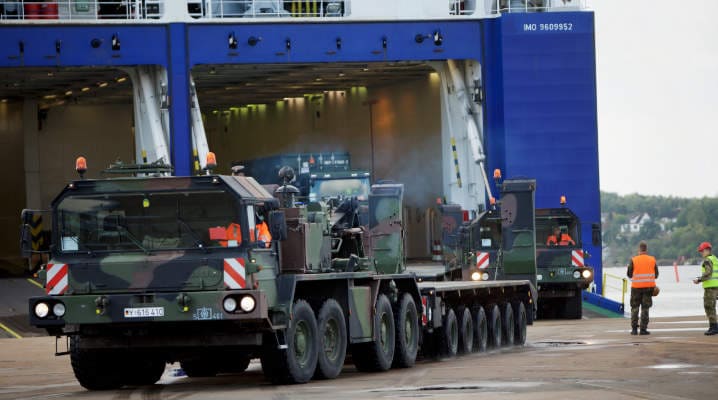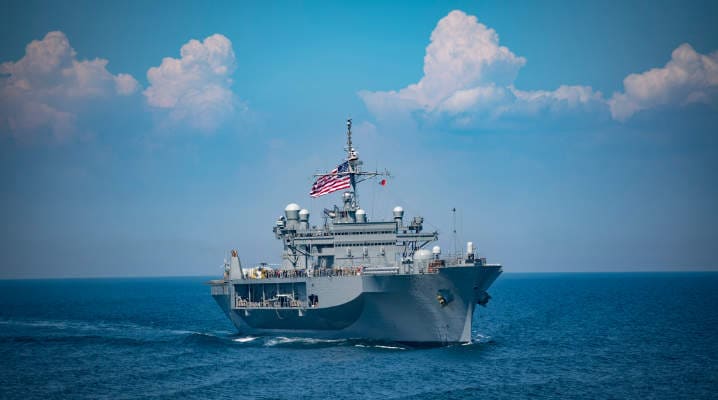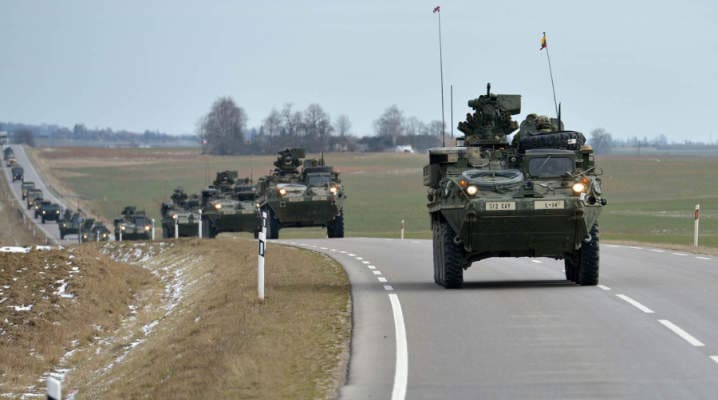Logistics is all or almost all of the field of military activities except combat.
Military mobility is essential for NATO’s deterrence and defence posture, and is now a key focus of cooperation with the European Union. Moving Allied forces into and across Europe at speed, and sustaining them, is a significant logistic challenge involving many stakeholders at national and multinational levels, which will be put to the test in Exercise Trident Juncture 18 this October and November.

A total of 92,000 metres of vehicles will be deployed to Norway for exercise Trident Juncture in October/November 2018. The first roll-on/roll-off ship arrived in Fredrikstad on 7 September. © Torgeir Haugaard/Norwegian Armed Forces
During the Cold War, NATO’s focus was on Central Europe with massive conventional forces deployed forward, facing eastwards, pushed hard up against the inner-German border in response to the Soviet threat. Field commanders held stated regional responsibilities, and all were well aware of the boundaries between forces and flanking formations, the likely combat and communication zones and the arrangements made with the respective host nations. National forces stretched back across NATO territories to the channel ports and established secure rear areas, which were specified and resourced as supply routes across the continent. This posture provided the basis for rapid reinforcement from North America across the North Atlantic and into Europe. All necessary arrangements, infrastructure, war stocks, lift capacity and very detailed plans were in place. And the ability to work together effectively was achieved through regular training and exercising at all levels.
When the Berlin Wall fell in 1989, the threat from the East was assumed to have disappeared, so the Allies drew down their forces and larger scale exercises were reduced. NATO focused its attention on ‘out of area’ operations, conducted by Allies. How, where and when operations were launched was for the North Atlantic Council – NATO’s principal political decision-making body – to decide. Military planning was initiated when such a decision was made, rather than executing an existing defence plan with troops being employed immediately, as was the case during the Cold War era.
The Ukrainian Crisis of 2014 heightened Allied concerns about a resurgent and assertive Russia. It underlined the need to be able to rapidly and confidently reinforce a threatened Ally on the periphery of NATO territory, to deter a potential threat and, should deterrence fail, to defend an Ally from an attack. Added to this, conflict in Syria and the upsurge in terrorism, cyberattacks and other forms of hybrid warfare against Allies have underscored the potential for conflict across the full domestic and international spectrum and the need for increased coordination to ensure readiness and resilience. It has also become clear that the Alliance needs to be able to do it all: from collective defence; to crisis management; to projecting stability beyond our borders; to contributing to combating terrorism. So, times have changed and the risks and burdens have increased.
Improving readiness
Since the historic decisions taken at the NATO Summits in Wales (2014) and Warsaw (2016) relating to NATO’s deterrence and defence posture, the Alliance has been getting stronger, faster and, with the accession of Montenegro, larger. The posture provides the Alliance with a broad range of options to be able to respond to the full variety of threats across the territories of Allies that have almost doubled in number since the Cold War, in some cases effectively multiplying the distances that might need to be covered in a deployment of force.
Today, from a conventional military standpoint, NATO maintains a very limited forward presence on its eastern periphery combined with an ability to rapidly reinforce, if necessary. As part of this, the enhanced Forward Presence of four multinational battlegroups in Poland and the Baltic States includes altogether over 4,500 troops from across the Alliance, able to operate alongside national home defence forces. And these are complemented by bilateral US presence under the European Deterrence Initiative. Additionally, a number of measures in the Black Sea region have increased NATO’s presence on land, at sea and in the air.

USS Mount Whitney will serve as the command ship at the heart of exercise Trident Juncture 2018. The ship can communicate globally far away from any shore, maintaining contact with all units and capabilities as well as reaching back to the civilian leadership for direction and guidance.
© US Navy
At the Brussels Summit (2018) Allies also adopted a NATO Readiness Initiative. It will ensure that high-quality, combat-capable national forces at high readiness can be made available to NATO. From within the overall pool of forces, Allies will offer 30 major naval combatants, 30 manoeuver battalions and 30 kinetic air squadrons, along with the enabling forces at 30 days’ readiness or less. This initiative will further enhance NATO’s rapid response capability, either for reinforcement of Allies, or for rapid military crisis intervention.
But it is important to note that the speed of reinforcing the forward deployed elements has many dimensions. It is not just about the level of readiness of our forces. The ability to provide timely reinforcement is also dependent upon such aspects as: quick decision-making supported by adequate intelligence, based on indicators and warnings that can register the various aspects of a hybrid campaign; advance planning and preparations; as well as the capacity to physically project and sustain the vast forces at NATO’s disposal, including from across the Atlantic Ocean. These are all areas that have been strengthened by NATO since 2014 to underwrite the Alliance’s posture and make it more capable, credible and relevant.
The practical art of moving armies
Warfare is not an exact science and, according to Baron de Jomini, a celebrated founder of modern military thought: “Logistics is all or almost all of the field of military activities except combat” (1838). In his day, Jomini viewed logistics as “the practical art of moving armies,” by which he meant the whole range of functions involved in moving and sustaining military forces: planning; administration; supply; billeting and encampments; bridge- and road-building; and even reconnaissance and intelligence insofar as they were related to manoeuvers away from the battlefield.
In this spirit, NATO seeks to remove obstacles to military movement into and across Europe and the North Atlantic, and to sustain its forces in a theatre of operations. To this end, work is being conducted in four areas: authorities and legislation to facilitate border crossing; command and control to direct the logistic moves; adequate lift capabilities that can transport troops and their equipment; and an infrastructure that can cope with large quantities of heavy military transport. At NATO, this broad effort is being referred to as “Enabling the Supreme Allied Commander Europe’s Area of Responsibility.”1 Military mobility is a shorter and more accessible term to cover specific elements within the broader programme.
Changes in border-crossing authorities and legislation at national and EU levels facilitate rapid deployment, in particular during peacetime. Work is underway by nations, the European Union and NATO to harmonise plans, processes and procedures, including diplomatic and other mobility clearances, so that troops and equipment can cross Europe’s borders without undue delay and impact on civilian life.
The Alliance Command and Control structures will also cooperate and coordinate with relevant national civilian actors to facilitate the transit of large numbers of forces into, across and from Europe. In this regard, at the Brussels Summit, Allied leaders decided on a more robust NATO Command Structure that includes logistic elements at all levels, including a Command in Norfolk, the United States, to facilitate rapid and secure reinforcement to Europe from across the Atlantic, as well as a Joint Support and Enabling Command in Ulm, Germany, to ensure freedom of operations, so that rapid movement of troops and equipment can take place at the required scale to the rear of the manoeuvre formations.

Transport infrastructure across Europe needs to be adequate to allow the transport of military forces and heavy material.
Pictured: A convoy of US 2nd Cavalry troops, during US Operation Dragoon Ride in March 2015, which was part of wider efforts to reassure NATO Allies on Russia’s western periphery. © Michael Abrams/Stars and Stripes
Additionally, NATO is encouraging Allies to enhance and increase transport capabilities through military capability development as well as through pre-negotiated contracts with the commercial sector across Europe, and work is underway to improve multinational and collective access to lift capacity. NATO is actually facilitating this process by offering to Allies the opportunity to pool resources and procure capabilities jointly, which adds efficiency and simplifies procedures. And the European Union, with its plans to allocate more funds to defence investment, is also making encouraging steps in this direction.
Working closely with the European Union
NATO cooperates with the European Union and other actors to ensure that civil and commercial transportation infrastructure, such as ports, roads and bridges, is up to the required standards – standards that will be used as a basis for national and potentially EU investments.
It would be unthinkable to address this work without the full cooperation of the European Union. As part of a combined effort, both organisations are working to address the removal of existing obstacles to military movement across the continent. The European Union has an important role to play in facilitating border crossing for the military and their equipment within Europe, as well as in ensuring that the transport infrastructure across Europe is adequate to allow the transport of military forces and heavy materiel.
NATO and the European Union have identified military mobility as a key area for cooperation between the organisations. The Joint Declaration signed in July 2018 by Secretary General Jens Stoltenberg and European Commission and Council Presidents Jean-Claude Juncker and Donald Tusk reaffirmed the interconnected security interests of NATO Allies and EU Member States and the importance of cooperation to underpin the defence initiatives of both organisations.
All of the above implies integration at three levels. First, in NATO, work is in motion to look at both combat capabilities and logistic enablers, recognising that logistics can be military, civil or commercial in nature. And all contributing elements need to train and exercise together, simulating wartime conditions – in other words, “train as you fight”.
Second, at the national level, a whole-of-government approach is being advocated to deal with the spectrum of hybrid challenges , including to coordinate logistic resources to support civil authorities and those required for military reinforcements. Cross-government coordination is also needed to make Allies more resilient to function in times of a crisis or conflict. Allies’ Heads of State and Government committed at the Warsaw Summit to enhance resilience through civil preparedness.
Finally, work is underway at a multilateral level to ensure that NATO and the European Union can work together seamlessly to enable NATO to defend the Euro-Atlantic region against potential adversaries, as well as project security and stability appropriately.
A long-term effort
While NATO’s essential mission has not changed since the Alliance was founded 70 years ago, much has changed since the end of the Cold War. A very modest presence on our periphery combined with the ability to rapidly reinforce Allies under pressure is a different posture altogether from hundreds of thousands of troops permanently based within shooting range of an adversary. And today, we have many more challenges to address beyond an assertive Eastern neighbour; insecurity and instability to our South, emerging cyber and other hybrid threats, piracy on the high seas, to name but a few.

NATO and the European Union have identified military mobility as a key area for cooperation in the Joint Declaration signed in July 2018 by Secretary General Jens Stoltenberg and European Commission and Council Presidents Jean-Claude Juncker and Donald Tusk. © NATO
NATO’s political leaders have acknowledged that deterrence and defence in Europe can be delivered through such a posture, but that enabling and sustaining those forces depend, among other things, on the ability to move forces and their equipment into and across Europe at speed. To become ever more effective in doing this, a long-term effort is underway. We are on the right track, but a lot more needs to be done.
As more than 30 contributing Allies and partner countries prepare to move their forces into Norway for Exercise Trident Juncture in October and November 2018, both military and civil practitioners brace themselves for this significant logistic challenge. At political and practical levels, the logistic challenge is complex and requires working together with stakeholders at national and multinational levels to ensure that all forces are at the Joint Commander’s disposal at the right place and time, no matter their point of origin.
A real scenario may not provide the time to brace. The readiness culture will take time to re-establish to the levels required and will need political will and financial investments. This is why it is so important that Allied leaders at the July NATO Summit once again reiterated that they will meet the Defence Investment Pledge, moving towards two per cent of GDP on defence by 2024. This increased spending, combined with national efforts to boost resilience and facilitate military mobility, bolstered by the parallel and coordinated work at the EU level, will enable NATO to continue doing today and tomorrow what it has done successfully in the past — guarantee the security of all its Allies.
1 The Area of Responsibility of the Supreme Allied Commander Europe (SACEUR) is defined as: The territory of Allies in Europe, the Atlantic Ocean from the North Pole to the Tropic of Cancer and up to the East Coast of North America.
